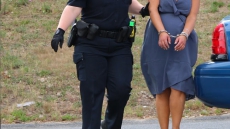EDMONTON — Wildfire experts say dangers from the Fort McMurray fire won't end when the flames stop.
Officials from California, where wildfires burn residential areas every summer, say ash left behind in a city is considerably more dangerous than ash from a burned forest.
Materials such as vinyl siding or nylon carpets tend to burn completely in the furnace-like temperatures of a blaze.
But heavy metals such as arsenic, chromium and lead are all left behind at levels that often exceed guidelines.
And residual ash, mixed with water, is almost as caustic as oven cleaner.
The California experts strongly advise that people returning to a burned-out site wear long clothes, gloves, masks and eye protection.
NOTLEY HEADS TO FIRE-DAMAGED FORT MCMURRAY AS PLANS BEGIN TO RETURN EVACUEES
EDMONTON — With fingers crossed and the weather outlook good for fire-ravaged Fort McMurray, Premier Rachel Notley and the first wave of planners hope to go to the city today to begin work on getting tens of thousands of evacuees back home.
Notley says she will meet up with the region's mayor Melissa Blake to assess the situation.

Notley and her officials, updating reporters Sunday, said crews will begin examining the damage from the blaze as well as check on infrastructure like natural gas lines and the power grid.
Scott Long, with the Alberta Emergency Management Agency, said saving the city from the wildfire was phase one.
"Now that we're going into phase two, which is stabilization of the situation … we're going to start getting some folks on the ground that can start having a look at those damage assessments and getting a better feel for it," said Long.
Crews were able to keep the flames from critical infrastructure, such as the hospital and water treatment plant.
The last damage assessment estimated 1,600 structures, mostly homes, burned in the south and southwest areas of the city, 435 kilometres northeast of Edmonton.
It has almost been a week since a wildfire, fuelled by strong winds, overwhelmed crews last Tuesday afternoon, cutting the main road through Fort McMurray and sending its 80,000 inhabitants fleeing north and south.
The southern evacuees took up residence at a main reception centre in Edmonton or in hotels, campgrounds or with friends.
The 25,000 evacuees forced to flee north to stay in oilsands work camps have now all been brought south to safety, where there are more supports and social services.

Chad Morrison, Alberta's senior wildfire manager, said crews received a break from the weather, with cooler than seasonal temperatures Sunday.
Those cooler temperatures were expected to continue for the next few days, giving crews a chance to reinforce defences around the city and put out any lingering hotspots within city limits.
"This is great firefighting weather. We can really get in there and really get a handle on this fire and really get a death grip on it," said Morrison.
The fire itself spans 1,600 square kilometres and by Sunday had moved to within 30 kilometres of the Saskatchewan boundary.
Federal Public Safety Minister Ralph Goodale, visiting an evacuation centre on Sunday in Edmonton, told reporters the dry conditions stretching from Quebec to British Columbia have already led to a number of wildfires early in the season.
"This is potentially a very long and difficult problem, not just for Albertans but for all Canadians this summer," said Goodale.
Scenes of devastation have already trickled out from Fort McMurray: images of razed neighbourhoods, torched trucks, and swing sets with the wooden seats burned off, leaving only drooping chains.
Notley said some media will be allowed into the city with her today and warned residents to brace themselves.
"There will be some dramatic images coming from media over the next couple of days," she said.

Morrison said the start of the blaze is still under investigation but added this kind, at this time of year, is usually caused by people.
More than 500 firefighters were on site, backed by 200 helicopters, 27 water bombers and 44 pieces of heavy equipment.
Notley is scheduled to meet leaders from the province's oil industry on Tuesday to discuss the state of their operations and a timeline for restarting them.
Syncrude and Suncor facilities north of Fort McMurray were evacuated but the fire did not reach them.
To date there have only been two deaths linked to the fire.
Emily Ryan, 15, and her stepmother's nephew, Aaron Hodgson, died last Wednesday in a head-on crash fleeing the blaze.
Notley remembered them on Sunday, Mother's Day.
"Our hearts go out to their families," said Notley, as she fought back tears.




